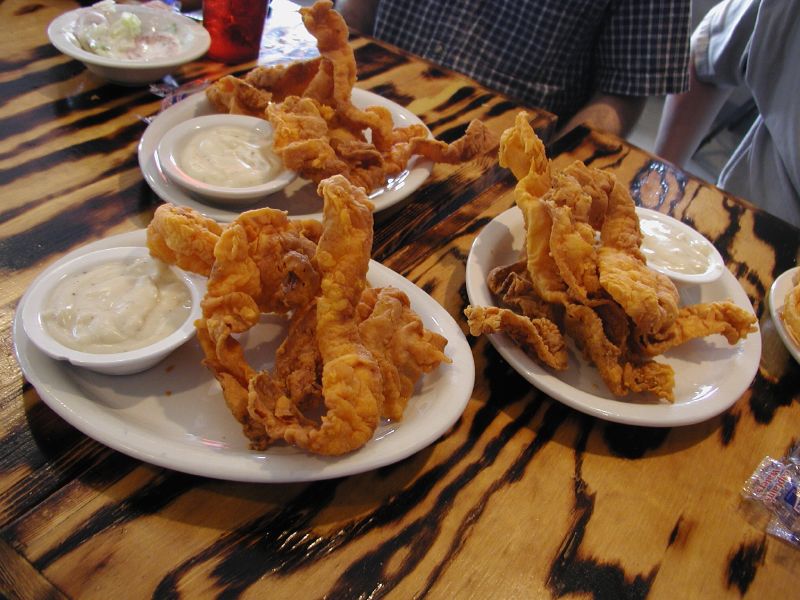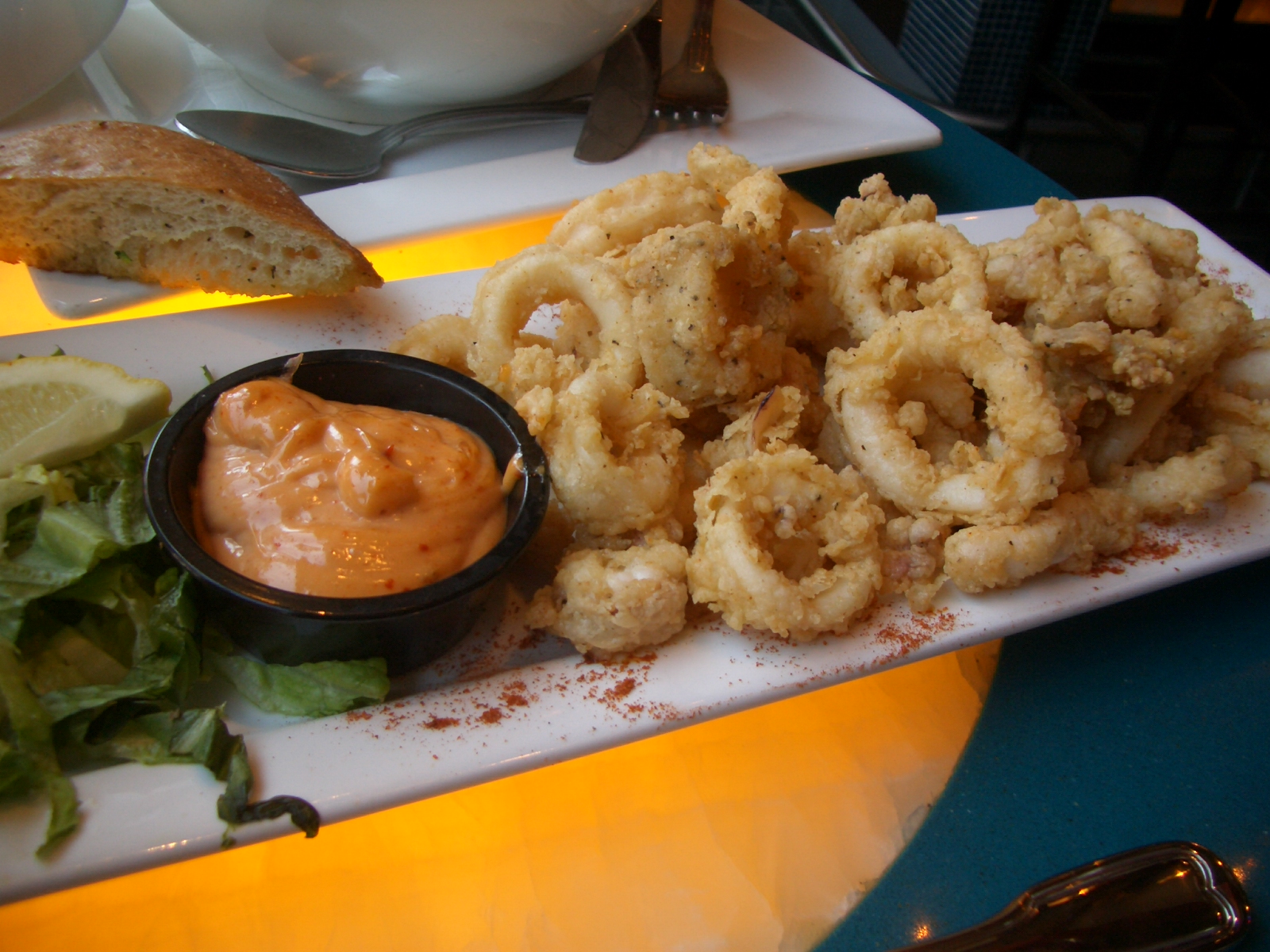Greasy Goodness
by Shuang Chen
Picture a nice hot bundle of crispy French fries fresh from the fryer. If your stomach starts gurgling vigorously, then keep on reading. It seems that a love of fried food is one thing that bridges cultures: rich and poor, black and white, Chinese and Mexican––you get the idea. I, for one, am obsessed with fried chicken, and don't even know why. Every time a Kentucky Fried Chicken (KFC) commercial comes on TV, my feet begin twitching and my stomach starts gurgling. If I don't satisfy the loud beast within thirty minutes, it would most definitely digest itself. But how do we explain this phenomenon, our addiction to fatty crispy things?
I took a piece of Original Flavor chicken thigh from the bucket, looked at it longingly, and finally bit down. For that brief moment when the juices burst out of the crispy shell and into my mouth, I had truly found paradise.
To “investigate” this question further, I decided to walk to the nearest KFC, which is twenty-six minutes away. As I placed the order for a twelve-piece chicken bucket, I gazed longingly at the chicken thighs emitting a faint orange glow under the heat lamps behind the cashier. During the tedious five minutes of waiting for my order, I felt a string of drool dripping out of the right side of my mouth and onto my green polo shirt. When the cashier handed me the bucket, her eyes fixed on the stain on my polo, and her face contorted to something resembling a raisin. I didn't care, though, because now I had my chicken, and all was fine in the world. As I took my Bucket-o-Goodness to the nearest table and sat down, I could feel my stomach waiting in anticipation like a tiger waiting in the bushes for his prey. I took a piece of Original Flavor chicken thigh from the bucket, looked at it longingly, and finally bit down. For that brief moment when the juices burst out of the crispy shell and into my mouth, I had truly found paradise.
I then began to wonder: when did humans start to fry their food? While it may be impossible to answer that question definitively, we do know that the practice of frying food has a long history. According to “Fried Dough History,” “the Roman scriblita, described by Cato in the 2nd Century BC, was the ancestor of both fritters and doughnuts” (Fried Dough History). Romans spooned lumps of moist dough into hot fat and cooked them. What was amazing to me, though, was that fried chicken dates back at least to medieval times. But, according to food engineering professors Serpil Sahin and Servet Gulum Sumnu, co-editors of Advances in Deep-Fat Frying of Foods (2009), it wasn't until centuries later that the Scottish started making something close to our modern-day fried chicken. Scottish immigrants then introduced fried chicken to the American South; African slave cooks enhanced the recipe by adding spices and seasonings. Only then did it become the fried chicken I love today.
My favorite delicious fried chicken is produced in the deep fryers of America, metal heaters containing large volumes of oil. Food is gradually lowered into the hot grease and then cooked slowly. A major problem, however, is that big pieces of chicken may lose moisture and dry out in the deep frying process, since meat must remain in the fryer for a long time so that it cooks thoroughly. To address this problem, new technologies have been developed in the past century, such as the pressure cooker made famous by fast food chain KFC. When the pieces of chicken are put into the tub of oil inside the cooker and then sealed, the water inside the chicken becomes steam and escapes through the oil in the airtight chamber, increasing the pressure and lowering the cooking temperature needed. The steam also cooks the chicken through, but still allows the piece to be moist and soft inside the crisp batter. That is the reason why store-bought fried chicken is usually moist on the inside, while the home-cooked variety can be very dry.
Deep frying, as dominant a cooking method as it may be, however, is not the only form of frying. And, despite its widespread appeal, not everyone enjoys deep-fried food. Sautéing, stir frying, pan frying, and shallow frying are all alternative methods. I am most familiar with stir frying since my dad owns a Chinese restaurant. The art of stir fry is fairly simple, as it can be summed up in four words––hot wok, cold oil. The chef heats the wok to a very high temperature, and then pours in a small amount of room-temperature oil. When the oil begins to smoke, other ingredients can be added. This method of frying cooks food quickly to prevent losing too much nutrition, so it is healthier (The Diet Channel).
Deep fried food seems almost the perfect food because it tastes great and can be stored for a long time, but I also must solemnly acknowledge its Achilles' heel––fat. Foods fried in fat tend to have, well, high amounts of fat. Countries that consume a high amount of fried goods tend to have higher obesity rates than countries with lower-fat diets. Spanish researchers followed nearly 34,000 Spanish adults participating in the European Prospective Investigation into Cancer and Nutrition between 1992 and 1996 to assess whether particular kinds of food choices related to the risk of developing obesity. Those study participants who had the highest intakes of fried foods were 25% more likely to be obese than those with the lowest intakes (American Journal of Clinical Nutrition). A 2005 Harvard Medical School study of over 14,000 Boston-area children found that “adolescents who eat a large amount of fried foods away from home are heavier and more likely to have a poor-quality diet” (News Release, Harvard Medical School Office of Public Affairs, 10/3/2005). These findings should not come as a shock to anyone, however, since fried foods are inherently energy-dense, packing a high number of calories inside a single serving. Besides the fat, there is also the issue of the crust. When one prepares deep-fried food, it usually needs a coating of flour or starch, which becomes simply a layer of empty carbohydrates. One might argue that frying foods without dredging them first would be healthier, but the taste would not be the same. America is one of the most obese nations in the world today, and its most popular foods are also fried (Forbes). Do you see a possible connection there?
From the common fried chicken, fried onion rings and fried shrimp, to the less-common fried Twinkies, fried candy bars and fried Oreos, there is no city in America devoid of fried delicacies.
Despite their health risks, fried foods in America are big, and I mean really big. From the common fried chicken, fried onion rings and fried shrimp, to the less-common fried Twinkies, fried candy bars and fried Oreos, there is no city in America devoid of fried delicacies. State fairs often give out monetary awards for new greasy fried food inventions that will stop your heart the fastest. By glancing over the Texas State Fair Choice Awards website, one can see entries of monstrosities such as Chicken Fried Bacon, Fried Banana Split, Fried Peaches n' Cream, Fried PBJ and Banana Sandwich, and worst of all, Deep Fried Butter (Choice Awards). The fried food mania is not just in Texas, either. In my family's Chinese restaurant in Pennsylvania, our three best-selling menu items are fried chicken wings, fried crab rangoon, and fried spring rolls. Seeing the hordes of overweight customers rushing through the doors every day just to get the super-fried-food combo--the three above-mentioned items plus fried shrimp toast, fried crab sticks, and fried scallops--makes me believe that fried food is not just food, but an addiction.

Chicken Fried Bacon with Cream Gravy, 2002, Snook, Texas Photo Credit: Cara Fealy Choate, Creative Commons License |
This obsession with fried foodstuff is not restricted to America either, as can be seen around the globe. Each country has its signature fried dish. China has fried egg rolls and fried dumplings; in the Middle East it's falafel–– fried balls of chickpeas. In Japan, they love tempura shrimp––shrimp covered in light wheat flour batter, and then fried in sesame oil to ensure maximum flavor. In Mexico it's tortilla chips and chalupas, deep-fried boat-shaped corn tortillas with various fillings. Indians eat papad or papadum—a thin fried cracker-like wafer- everywhere from sidewalks to homes and every meal from snacks to dinners. In the United Kingdom, the traditional dish of fish and chips remains popular; it consists of fried battered cod, haddock or flounder and fried thick-cut potatoes, resembling American French fries. Italians love fried calamari–– lightly battered fried squid. Enjoying deep fried food is clearly a global phenomenon.

Photo Credit: Creative Commons License |
Spices such as pepper and paprika dissolve better in fat than in aqueous mediums, making fat an excellent flavor carrier. Compare beef stock to beef gravy, and you can taste the difference.
So what makes fried foods so tasty that so few people can resist? From a chemical standpoint, it can be reasoned that fat is more flavor-soluble than water. Spices such as pepper and paprika dissolve better in fat than in aqueous mediums, making fat an excellent flavor carrier. Compare beef stock to beef gravy, and you can taste the difference. This is why we cook with fat, whether butter in baking or oil in sautéing-- to bring out the most intense flavors of the ingredients.
From a biological perspective, the 10,000 taste buds on the tongue discovered by Philippe Besnard, a nutritionist from the University of Burgundy, “seem to include a type that specifically responds to the flavor of fat”(Svitil). This discovery may very well explain why foods such as fried chicken taste so good. Right now our tongue is identified as having five types of taste buds: sweet, sour, bitter, salty, and Umami or savory. (Umami may be unfamiliar to many people due to its recent discovery. To explain it simply, it is the reason why MSG makes food tastier.) If fat then is the sixth taste, it means that fat plays a more prominent role in flavor than previously thought. But there are no other scientists to back Philippe Besnard on this scientific discovery yet, so we do not know for sure if our tongues truly contain these “fat taste-buds.”
From an anthropological view, “back in our murky past, early humans had to consume as many calories as possible when they were available, since food was scarce. Fat is calorie-dense, so humans evolved to like the taste of fats and oils. They would seek them out and consume them to survive” (LiveFitBlog). One aspect of Darwin's survival of the fittest theory applies here, as eating fatty foods grants you enough energy to be among the “fittest.” That habit of seeking out fatty foods might have passed down the generations, making us fat-craving machines of obesity (Chessher).
The human love affair with fried food in all its varieties is most likely attributable to a combination of biological, chemical, and anthropological factors. There is no definitive answer, but that's not stopping billions of people in the world from succumbing to their cravings. I predict, based on the trends set by the many generations before us that fried food, in all of its glory, will remain in the human diet for a long time… unless the fat from the greasy goodness kills us first.
Works CitedChessher, Melissa. "Your Brain Is Hardwired for Fattening Foods - TODAY Health - TODAYshow.com." 7 July 2010. Web. 25 July 2010.
<http://today.msnbc.msn.com/id/37500495/ns/health-diet_and_nutrition/>.
"Choice Awards." BigTex.com. Web. 04 Nov. 2009.
<http://www.bigtex.com/foodlocator/ChoiceAwards.asp>.
"Why does butter taste good?: Butter." Web Exhibits. Web. 04 Nov. 2009.
<http://www.webexhibits.org/butter/taste.html>.
Greg "Why Does Fat Taste Good?" Live Fit Blog. Web. 04 Nov. 2009. <http://livefitblog.com/2009/01/15/fat-tastes-good>.
Gourley, Leh. "Harvard Medical School Press Release." Web. 09 Nov. 2009.
<http://web.med.harvard.edu/sites/RELEASES/html/10_3tavares.html>.
Guallar-Castillón et al. "Intake of Fried Foods Is Associated with Obesity in the Cohort of Spanish Adults from the European Prospective Investigation into Cancer and Nutrition -- 86 (1): 198." American Journal of Clinical Nutrition . July 2007. Web. 25 July 2010. <http://www.ajcn.org/cgi/content/full/86/1/198#T1>.
Sahin, Serpil and Servet Gulum Sumnu (eds). Advances in Deep-Fat Frying of Foods (Contemporary Food Engineering Series). Boca Raton, Florida: CRC Press, 2009.
"Stir-Frying: What Makes It Healthy?" The Diet Channel. Web. 25 July 2010.
<http://www.thedietchannel.com/Stir-Frying-Is-Healthy.htm>.
Svitil, Kathy A. "Why Fat Tastes So Good." Discover. 20 Feb. 2006. Web. 11 Nov. 2009. <http://discovermagazine.com/2006/feb/why-fat-tastes-so-good>.
"All About the History & Evolution of Fried Doughs." Comcast.net: Personal Web Pages. Web. 30 Nov. 2009.
<http://home.comcast.net/~osoono/history.htm>.
"World's Fattest Countries - Forbes.com." Forbes.com . 2 Aug. 2007. Web. 25 July 2010.
<http://www.forbes.com/2007/02/07/worlds-fattest-countries-forbeslife-cx_ls_0208worldfat_2.html>.
 Shuang Chen, Class of 2013, is majoring in Management Science through MIT's Sloan School of Management. He hails from the mystical Far East country known as "China." Shuang enjoyed his first bucket of Kentucky Fried Chicken in China at the age of nine and moved to the United States three years later to pursue his culinary addiction to greasy foods. By some coincidence, Shuang stumbled onto the steps of the most prestigious school in Cambridge and as one thing led to another, he became a Beaver.
Shuang Chen, Class of 2013, is majoring in Management Science through MIT's Sloan School of Management. He hails from the mystical Far East country known as "China." Shuang enjoyed his first bucket of Kentucky Fried Chicken in China at the age of nine and moved to the United States three years later to pursue his culinary addiction to greasy foods. By some coincidence, Shuang stumbled onto the steps of the most prestigious school in Cambridge and as one thing led to another, he became a Beaver.